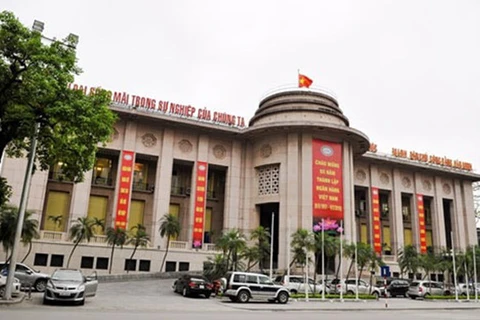Hanoi (VNA) - Since mid-February interest rates on VND loans on the inter-bank market have surged, somewhat surprising analysts since liquidity at most banks is pretty steady.
In the first week of March interbank rates for all tenors went up by 30-70 basis points from less than 4 percent.
In fact, the average interest rate on the interbank market rose rather sharply, especially for overnight loans, by 0.66 percent a year to 4.22 percent.
The rates for one-week and two-week loans went up by 0.36 percent and 0.28 percent to 4.32 percent and 4.44 percent per year, while one-month rates hardened by 0.3 percent to 4.74 percent.
Some analysts said though liquidity in the banking sector is still high, it has reduced a bit.
They pointed to the fact that the State Bank of Vietnam has been injecting money steadily in recent times through open market operations (OMO).
According to Bao Viet Securities Company, between February 20 and 24 the central bank pumped in 15.715 trillion VND (698.4 million USD) through OMO. Meanwhile, bonds worth 5.036 trillion VND have matured.
Also during this period the central bank issued seven- and 14-day treasury bonds worth 7 and 9 trillion VND, while bonds worth 49.9 trillion VND fell due.
This means a total 33.9 trillion VND was pumped into the economy via treasury bills.
Rising interest rates on the inter-bank market has helped stabilise the dollar-dong exchange rate after a strong rise by the dollar in recent times.
Many analysts opined that the higher inter-bank rates would not last long, and expect them to fall sharply right in the end of the first quarter.
Others said the increasing rates are not a cause for concern since the inter-bank rates remain below the levels that require the central bank to intervene.
Besides, the banking sector’s loans-to-deposits ratio remains at 80-85 percent, meaning liquidity is good.
In other words, the increase in the inter-bank rates is merely seasonal, they said.
In the early part of the month credit institutions often park their money with the SBV to meet compulsory reserve requirements, and in the latter part actively lend money.
That is why inter-bank interest rates often rise in the first and second weeks of a month and decrease later on.-VNA
In the first week of March interbank rates for all tenors went up by 30-70 basis points from less than 4 percent.
In fact, the average interest rate on the interbank market rose rather sharply, especially for overnight loans, by 0.66 percent a year to 4.22 percent.
The rates for one-week and two-week loans went up by 0.36 percent and 0.28 percent to 4.32 percent and 4.44 percent per year, while one-month rates hardened by 0.3 percent to 4.74 percent.
Some analysts said though liquidity in the banking sector is still high, it has reduced a bit.
They pointed to the fact that the State Bank of Vietnam has been injecting money steadily in recent times through open market operations (OMO).
According to Bao Viet Securities Company, between February 20 and 24 the central bank pumped in 15.715 trillion VND (698.4 million USD) through OMO. Meanwhile, bonds worth 5.036 trillion VND have matured.
Also during this period the central bank issued seven- and 14-day treasury bonds worth 7 and 9 trillion VND, while bonds worth 49.9 trillion VND fell due.
This means a total 33.9 trillion VND was pumped into the economy via treasury bills.
Rising interest rates on the inter-bank market has helped stabilise the dollar-dong exchange rate after a strong rise by the dollar in recent times.
Many analysts opined that the higher inter-bank rates would not last long, and expect them to fall sharply right in the end of the first quarter.
Others said the increasing rates are not a cause for concern since the inter-bank rates remain below the levels that require the central bank to intervene.
Besides, the banking sector’s loans-to-deposits ratio remains at 80-85 percent, meaning liquidity is good.
In other words, the increase in the inter-bank rates is merely seasonal, they said.
In the early part of the month credit institutions often park their money with the SBV to meet compulsory reserve requirements, and in the latter part actively lend money.
That is why inter-bank interest rates often rise in the first and second weeks of a month and decrease later on.-VNA
VNA
























